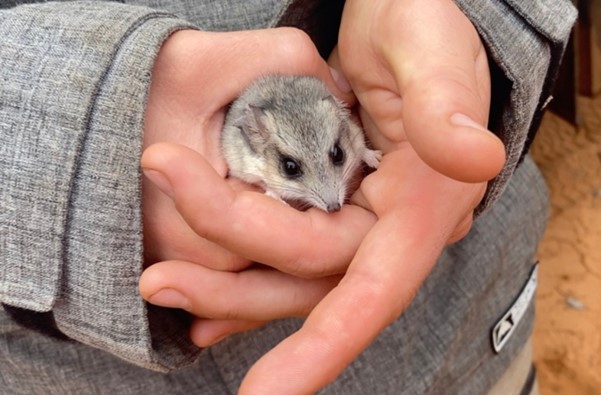
The elusive sandhill dunnart has been discovered living in the Yellabinna Wilderness Protection Area of remote South Australia, providing hope for the conservation of the species.
Ecologist Brett Backhouse from the Alinytjara Wilurara Landscape Board led a survey team that confirmed the presence of the rare sandhill dunnart in the area 150 kilometres north of Ceduna.
The team says that they are delighted with the dunnart discovery as well as finding several other native animals.
“Now we know they’re still up here and breeding, which is fantastic,” Backhouse said.
Sandhill dunnarts are listed as a vulnerable species and are only known to inhabit small areas of remote South Australia and Western Australia.
There was a huge concern for the future of the dunnart in 2020 after much of their habitat was destroyed by bushfires. This was of particular concern on Kangaroo Island where the habitat of the critically endangered Kangaroo Island dunnart was ravaged by fire.
One young female sandhill dunnart was caught during the most recent survey using pitfall traps placed in likely habitat locations. Ecologists gave her a health check and weigh-in before releasing her back into the wild.
The discovery of this little marsupial proved that the species is still breeding in the area and also gives important insight into where researchers and conservationists can find them in the future.
“It further refines our thinking of where they’re going to be and gives us a good idea of what is going to be key habitat,” Backhouse said.
“We’ve done some spinifex grass measurements at each of the trapping sites. Then we can compare it to other locations where we’re getting sandhill dunnarts, and not getting them as well, so it’ll provide even more of a robust idea of what they like and what they need.”
The discovery is a promising step toward protecting this vulnerable species. Knowing the location of these creatures means that measures can be put in place to protect them from predators and habitat destruction.
The small quoll or mulgara-like creatures spend their days asleep in sandy burrows but emerge to hunt insects, arachnids and small reptiles at night. They rely on spikey plants to protect them from their predators, so finding these types of plants aids ecologists in their search.Bottom of Form
Backhouse said the next step in his research is finding the exact type of habitat the sandhill dunnarts enjoy most.
“We know roughly the area that they like to be in post-bushfire, but we’re still trying to work out the spinifex habitat they prefer,” he said.
“Hopefully we can then look at some large-scale mapping by satellite that can start to indicate key areas in Yellabinna and Yumbarra, and other areas, and work on conservation methods to keep securing sandhill dunnarts and other species into the future.”
By Krystal Hender
Photo: Sandhill dunnart captured in Yellabinna Wilderness Protection Area (supplied)
Seniors Card is a Program Partner of the 2022 Regional Showcase program



